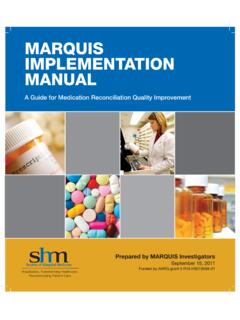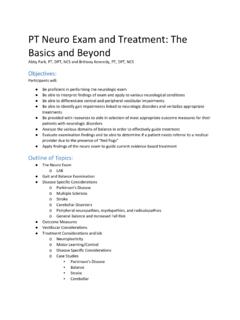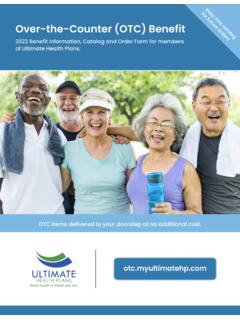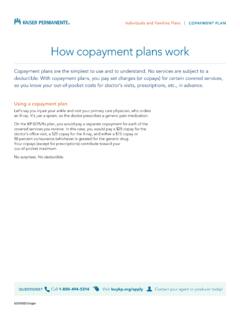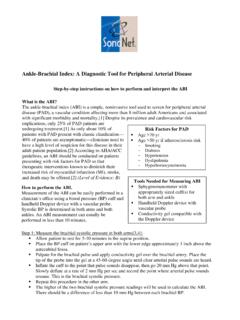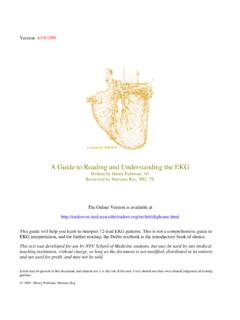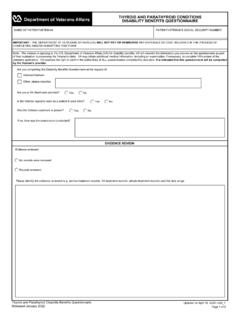Transcription of SUBJECTIVE GLOBAL ASSESSMENT (SGA)
1 SUBJECTIVE GLOBAL ASSESSMENT (SGA) ChangeMaximum weight_____ Wt 1 year ago_____ Wt 6months ago_____ Current Wt_____Overall loss in past 6 months:amount = #_____lbs; % loss = in past 2 weeks: _____increase,_____no change, history: (Change in clothing size, loose fitting )A=No significant change; B=5-10% weight loss; C= 10% or more sustained weight intake change (relative to normal)(Have eating patterns changed over last weeks or months? Has amount of food eaten changed? Arecertain foods they used to eat that they no longer eat? What happens if they try to eat more? How doestypical breakfast, lunch, dinner compare with six to twelve months ago?)A=No significant change; B=poor but improving or borderline but declining; C=starvation, unable to symptoms (that persisted for > 2 weeks)___none (A), ___Some symptoms (B) (nausea, vomiting, diarrhea, anorexia. ___Many symptoms (C) capacity____No dysfunction ( , full capacity),(A)____Dysfunction : mild (B); ____Severe (C) _____duration = # and its relation to nutritional requirementsMetabolic demand (stress): _____no stress (A),_____low-moderate stress (B), _____high stress (C) (for each trait specify: A = normal, B = mild-moderate, C = severe).)
2 # _____loss of subcutaneous fat (triceps, chest)# _____muscle wasting (quadriceps, deltoids)# _____ankle edema# _____sacral edema# rating (select one)_____A = Well nourished_____B = Moderately (or suspected of being) malnourished_____C = Severely malnourishedWater TestOffer alert patient 70 ml of water to if able to swallow without choking, coughing or spitting out the water (if positive consider diagnosis of oropharnegealdysphagia)Reproduced from: SUBJECTIVE GLOBAL ASSESSMENT in: Covinsky KE, Martin GE, Beyth RJ, et al. The relationship between clinicalassessments of nutritional status and adverse outcomes in older hospitalized medical patients. J Am Geriatr Soc 1999; 47 Toolbox for Geriatric Care 2004 Society of Hospital Medicine1 of 7 APPENDIXA ssessing the Nutritional Status of Dialysis Patients UsingSubjective GLOBAL ASSESSMENT (SGA)INTRODUCTIONB ecause nutritional ASSESSMENT is difficult, a new technique called SUBJECTIVE GLOBAL ASSESSMENT (SGA)was developed.
3 Its ratings have been found to be highly predictive of ,2,3 The procedure is easyto learn and simple to implement. SGA requires no additional laboratory testing or capital outlay. Inaddition, SGA has been found to correlate strongly with other SUBJECTIVE and objective measures originally used to categorize surgical patients, this nutritional classification system has beenshown to be a reliable nutritional ASSESSMENT tool for dialysis ,5 Fenton6 found that survival ofpatients classified as malnourished by SGA was significantly lower than patients classified as nourished,lthough he did not perform analyses to establish nutritional status as an independent risk classifies the patient as:A. Well-nourishedB. Mildly malnourished or suspected of malnutritionC. Severely malnourishedClinicians place the patient into one of these categories based upon their SUBJECTIVE rating of the patientin two broad areas: 1. Medical History, 2.
4 Physical general, 60% of the clinician's rating of the patient is based on the results of the medical history, and40% on the physical examination (see SGA evaluation form in figure 1).Medical History SectionThe first SGA component, the medical history, involves asking questions and evaluating the patient'sanswers about the following four parameters: Weight change Dietary intake Gastrointestinal symptoms Functional impairmentThe patient is rated as either nourished, mildly, moderately malnourished, or severely malnourished foreach of the four Examination SectionPhysical evidence of malnutrition is rated differently. There are four categories to select from: normalnutrition, mild malnutrition, moderate malnutrition, or severe signs to examine include:Appendixfile:///C|/WINNT/ (1 of 3) [9/3/2003 11:33:47 AM]Clinical Toolbox for Geriatric Care 2004 Society of Hospital Medicine2 of 7 Loss of subcutaneous fat Muscle wasting Edema Ascites (in hemodialysis patients only)There are several body locations to examine for each SCORING GUIDELINESThe clinician rates each medical history and physical examination parameter as either an A, B, or C onthe SGA Scoring Sheet.
5 On the basis of all of these parameters ratings, the clinical observer assigns anoverall SGA classification which corresponds to his or her SUBJECTIVE opinion of the patient s is not a numerical scoring system. Therefore it is inappropriate just to add the number of A, B, andC ratings to arrive at the overall SGA classification. The clinician should examine the form to obtain ageneral feel for the patient s status. If there seem to be more checks on the right-hand side of the form(more B and C ratings), the patient is more likely to be malnourished. If the ratings seem to be on theleft-hand side, the patient is likely to be severely malnourished (C) rating is given whenever a patient has physical signs of malnutrition suchas, severe loss of subcutaneous fat, severe muscle wasting, or edema, in the presence of a medical historysuggestive of risk, such as continuing weight loss with a net loss of 10% or more, or a decline in dietaryintake.
6 GI symptoms and functional impairments usually exist in these patients. Severely malnourishedpatients will rank in the moderate to severe category in most sections of the SGA weight loss is 5-10% with no subsequent gain, in conjunction with mild subcutaneous fat ormuscle loss and a reduction in dietary intake, the patient is assigned the mildly/moderately malnourished(B) rating. These patients may or may not exhibit functional impairments or GI symptoms. The B ratingis expected to be the most ambiguous of all the SGA classifications. These patients may have a rankingin all three categories. In general, if the severely malnourished (C), or well-nourished (A) rating is notclearly indicated, assign the patient to the moderately malnourished the patient has no physical signs of malnutrition, no significant weight loss, no dietary difficulties, nonutritionally related functional impairments, or no GI symptoms which might predispose to malnutrition,the patient should be assigned to the well-nourished (A) the patient has recently gained weight, and other indicators, such as appetite, show improvement, thepatient may be assigned the A rating, despite previous loss of fat and muscle which may still bephysically apparent.
7 On the other hand, obese patients can be moderately or severely malnourished basedupon their poor medical history and signs of muscle loss. Even patients with a normal appearance couldbe classified as mildly or moderately malnourished because of a poor medical Provided by: Baxter Healthcare Corporation, Renal Division, 1620 Waukegan Road,McGaw Park, IL 60085, Tel: (847) 473-6030, Fax: (847) 473-6935, e-mail: (2 of 3) [9/3/2003 11:33:47 AM]Clinical Toolbox for Geriatric Care 2004 Society of Hospital Medicine3 of 71. Jeejeebhoy KN, Detsky AS, Baker JP: ASSESSMENT of nutritional status. J Parent Nutr 55:193S-1965, Baker JP, Detsky AS, Wesson DE, Wolman SL, Stewart S, Whitewa J, Langer B, Jeejeebhoy KN:Nutritional ASSESSMENT : A comparison of clinical judgment and objective measurements. N Engl J Med306, 16:969-972, Detsky AS, McLaughlin JR, Baker JP, Johnston N, Whittaker S, Mendelson RA, Jeejeebhoy KN:What is SUBJECTIVE GLOBAL ASSESSMENT ?
8 J Parent Nutr 1:813-817, Young GA, Kopple JD, Lindholm B, Vonesh EF, De Vecchi A, Scalamogna A, Castelnova C,Oreopoulos DG, Anderson GH, Bergstrom J, DiChiro J, Gentile D, Nissenson A, Sakhrani L, BrownjohnAM, Nolph KD, Prowant BF, Algrim CE, Martis L, Serkes KD: Nutritional ASSESSMENT of continuousambulatory peritoneal dialysis patients: An intentional study. Am J Kidney Dis 17:462-471, Enia G, Sicuso C, Alati G, Zoccali C: SUBJECTIVE GLOBAL ASSESSMENT nutrition in dialysis patients. J AmSoc Nephrol 1:323, Fenton SSA, Johnston N, Delmore T, Detsky AS, Whitewall J, O Sullhan R, Cattran DC, RichardsonRMA, Jeejeebhoy KN: Nutrition ASSESSMENT of continuous ambulatory peritoneal dialysis patients. TransAm Soc Artif Organs 23:650-653, :///C|/WINNT/ (3 of 3) [9/3/2003 11:33:47 AM]Clinical Toolbox for Geriatric Care 2004 Society of Hospital Medicine4 of 7 SUBJECTIVE GLOBAL ASSESSMENT Scoring SheetPatient Name:_____Patient ID:_____Date:_____Part 1: Medical History SGA Score1.
9 Weight ChangeAB CA. Overall change in past 6 Percent change: _____ gain - < 5% loss _____ 5-10% loss _____ > 10% lossC. Change in past 2 weeks: _____increase _____ no change _____decrease2. Dietary IntakeA. Overall change: _____no change _____changeB. Duration: _____weeksC. Type of change: _____suboptimal solid diet_____ full liquiddiet _____hypocaloric liquid_____ starvation3. Gastrointestinal Symptoms (persisting for >2 weeks)____none _____nausea _____vomiting____ diarrhea_____ anorexia4. Functional Impairment(nutritionally related)A. Overall impairment:nonemoderatesevereB. Change in past 2 weeks:improvedno changeregressedPart 2: Physical Examination SGA Score Normal Mild Moderate Severe5.
10 Evidence of:Loss of subcutaneous fatMuscle wastingEdemaAscites (hemo only)Part 3: SGA Rating (check one)A. Well-NourishedB. Mildly-Moderately MalnourishedC. Severely MalnourishedClinical Toolbox for Geriatric Care 2004 Society of Hospital Medicine 5 of 7 SUBJECTIVE GLOBAL ASSESSMENT (SGA)Subject Name:_____History Number_____Study ChangeMaximum weight_____ Wt 1 year ago_____ Wt 6months ago_____ Current Wt_____Overall loss in past 6 months: amount = #_____lbs; % loss = in past 2 weeks: _____increase,_____no change, history: (Change in clothing size, loose fitting ) intake change (relative to normal)(Have eating patterns changed over last weeks or months? Has amount of food eaten changed? Arecertain foods they used to eat that they no longer eat? What happens if they try to eat more? Howdoestypical breakfast, lunch, dinner compare with six to twelve months ago?)
